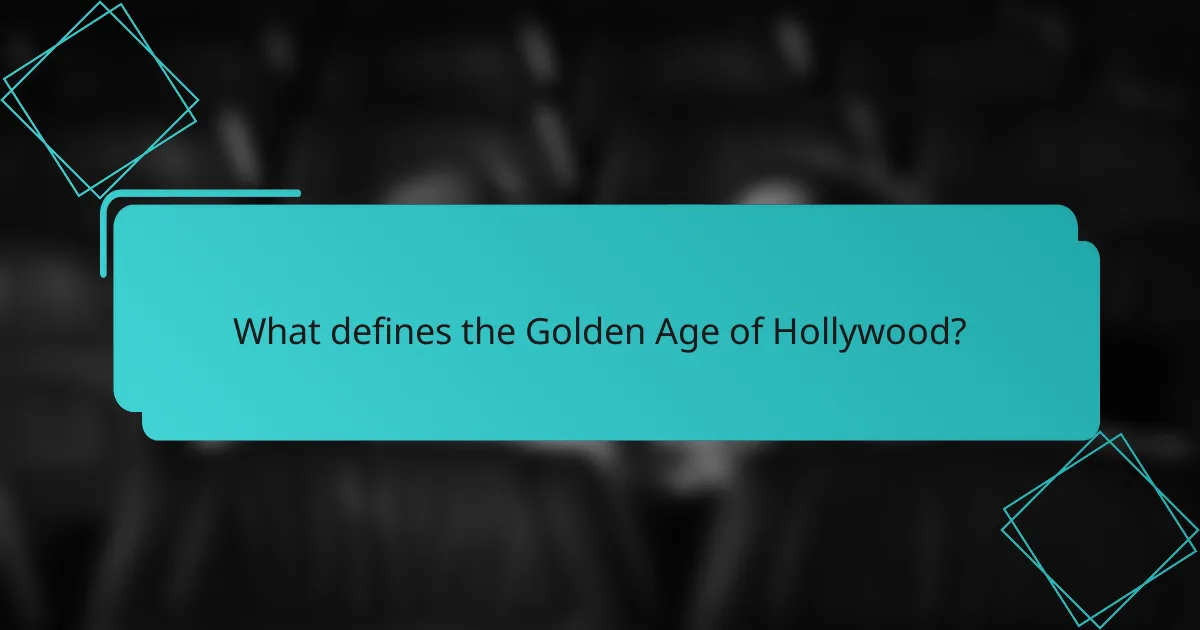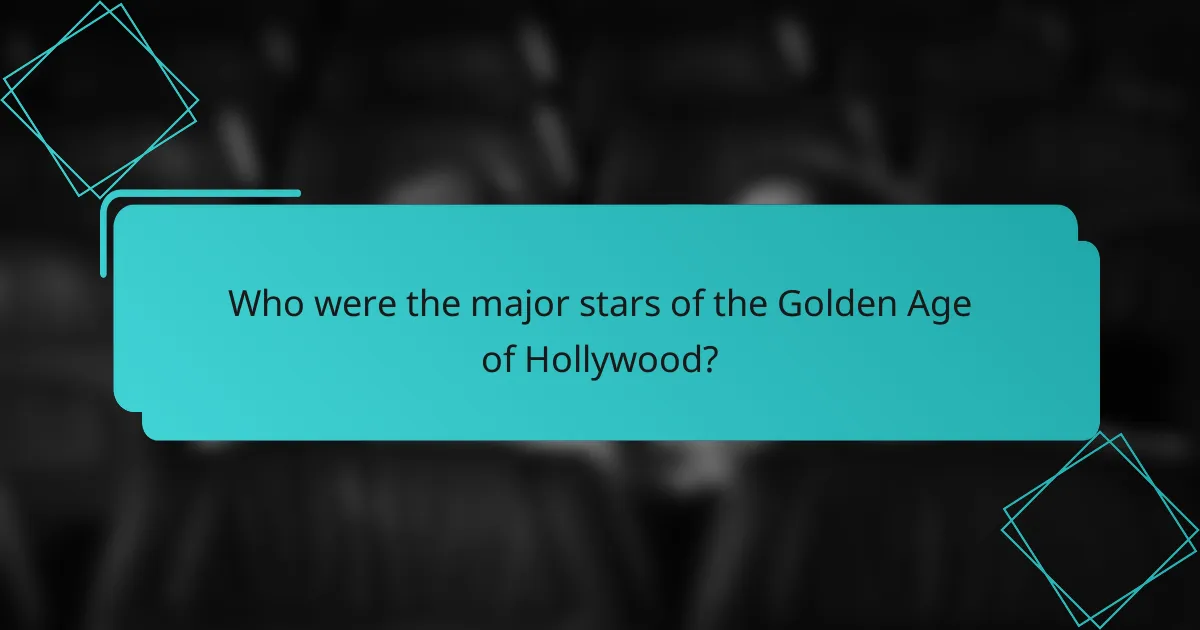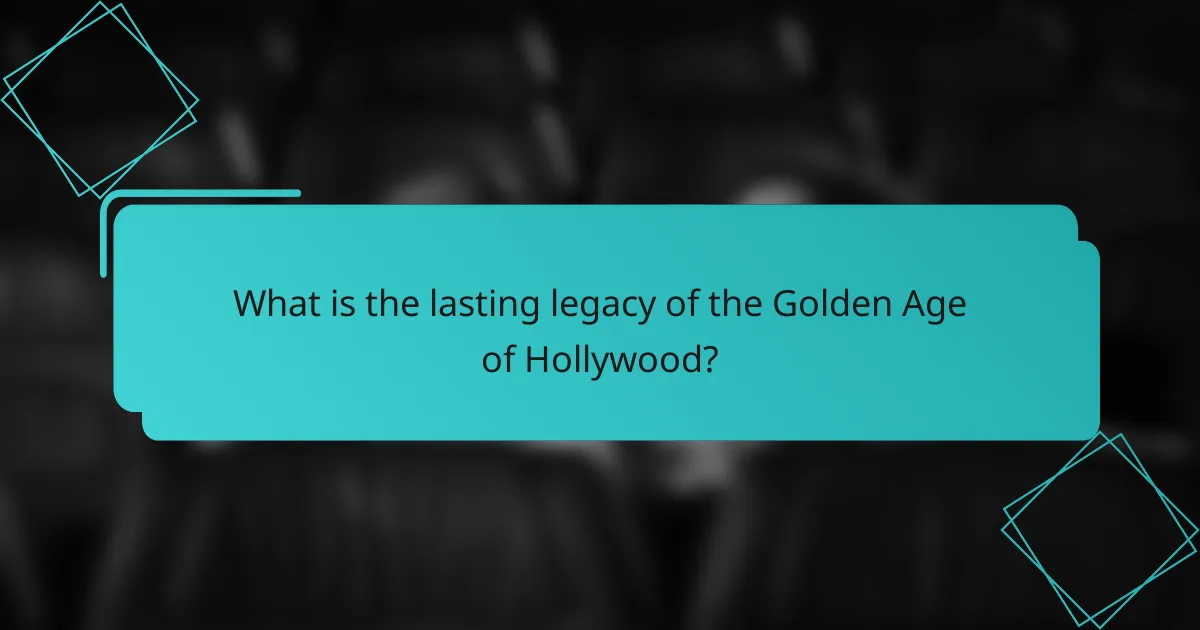The Golden Age of Hollywood refers to a transformative period in the American film industry, spanning from the late 1920s to the early 1960s, marked by the rise of major studios and the establishment of the studio system. This era produced iconic films and established foundational storytelling techniques, with notable genres such as musicals and film noir emerging. Prominent stars like Humphrey Bogart, Katharine Hepburn, and Marilyn Monroe became cultural icons, significantly shaping popular culture and public perceptions of fame. The legacy of this period continues to influence modern cinema, as its storytelling methods and cinematic styles remain relevant in today’s film industry.

What defines the Golden Age of Hollywood?
The Golden Age of Hollywood is defined by a period of significant growth and influence in the American film industry. This era primarily spanned from the late 1920s to the early 1960s. It saw the rise of major studios and the establishment of the studio system. Iconic films emerged during this time, shaping cinematic storytelling and techniques. Prominent stars, such as Marilyn Monroe and Humphrey Bogart, became cultural icons. The introduction of sound in films revolutionized the industry, enhancing audience engagement. Additionally, this period produced classic genres, including musicals and film noir. The Golden Age left a lasting legacy on filmmaking and popular culture, influencing generations of filmmakers and audiences.
How did the Golden Age of Hollywood come to be?
The Golden Age of Hollywood emerged due to several key factors. The establishment of the studio system in the 1920s centralized film production. Major studios like MGM, Warner Bros, and Paramount controlled the industry. The introduction of sound in films, known as “talkies,” in the late 1920s transformed the cinematic experience. This innovation attracted larger audiences and increased box office revenues.
The Great Depression also played a role, as movies became a popular form of escapism. The government’s New Deal programs provided funding for the arts, including film. Iconic stars like Clark Gable and Greta Garbo became household names during this era. The combination of technological advancement, economic conditions, and star power solidified the Golden Age of Hollywood from the late 1920s to the early 1960s.
What historical events influenced the Golden Age of Hollywood?
The Golden Age of Hollywood was influenced by several historical events. The Great Depression led to a demand for escapism in entertainment. World War II also impacted film production, as movies were used for propaganda and morale boosting. The post-war economic boom increased disposable income, allowing more people to attend movies. The rise of television in the 1950s forced Hollywood to innovate and adapt. Additionally, the Hays Code established strict guidelines for film content, shaping the narratives and themes of the era. These events collectively defined the landscape of Hollywood during its golden age.
How did technological advancements shape the film industry during this era?
Technological advancements significantly shaped the film industry during the Golden Age of Hollywood. Innovations like sound technology transformed silent films into “talkies.” This shift began in 1927 with “The Jazz Singer,” the first feature-length film with synchronized sound. The introduction of color film also changed the visual landscape. Films like “The Adventures of Robin Hood” in 1938 showcased vibrant color, enhancing storytelling. Additionally, advancements in special effects expanded creative possibilities. Techniques such as matte painting and miniatures were widely used in films like “King Kong” (1933). These technologies not only improved production quality but also attracted larger audiences. The combination of sound, color, and special effects defined the cinematic experience of the era.
What are the key characteristics of films from the Golden Age of Hollywood?
Films from the Golden Age of Hollywood are characterized by their strong narratives, glamorous stars, and high production values. These films often featured elaborate sets and costumes, reflecting the opulence of the era. The storytelling typically followed a clear three-act structure, ensuring engaging plots. Genres such as musicals, film noir, and romantic comedies were prevalent during this period.
Cinematography in these films was notable for its use of innovative techniques, including deep focus and expressive lighting. The presence of iconic stars like Humphrey Bogart and Audrey Hepburn drew audiences to theaters. Additionally, the influence of the Hays Code led to sanitized content that adhered to moral standards of the time.
The Golden Age spanned from the late 1920s to the early 1960s, shaping the foundation of modern filmmaking. Films produced during this era are still celebrated for their artistic achievements and cultural impact.
What genres were most popular during the Golden Age?
The most popular genres during the Golden Age of Hollywood were musicals, westerns, and film noir. Musicals captivated audiences with their vibrant dance numbers and memorable songs. Westerns showcased rugged landscapes and heroic cowboys, appealing to American ideals. Film noir introduced darker themes and complex characters, often exploring crime and moral ambiguity. These genres dominated box offices and shaped cinematic trends from the 1920s to the 1960s. The success of films like “Singin’ in the Rain,” “Stagecoach,” and “Double Indemnity” exemplifies their popularity and cultural impact.
How did storytelling techniques evolve in films from this period?
Storytelling techniques in films evolved significantly during the Golden Age of Hollywood. This period saw the introduction of complex narratives and character development. Filmmakers began to explore themes of morality and human emotion. The use of sound and color enhanced storytelling depth. Flashbacks and nonlinear narratives became more common. Influential films like “Gone with the Wind” showcased epic storytelling. The focus shifted from simple plots to intricate story arcs. This evolution laid the groundwork for modern cinematic storytelling.

Who were the major stars of the Golden Age of Hollywood?
The major stars of the Golden Age of Hollywood included icons such as Humphrey Bogart, Katharine Hepburn, and Clark Gable. Humphrey Bogart was known for his roles in films like “Casablanca” and “The Maltese Falcon.” Katharine Hepburn won four Academy Awards for Best Actress, showcasing her talent in movies such as “Guess Who’s Coming to Dinner.” Clark Gable became famous for his performance in “Gone with the Wind,” which is one of the highest-grossing films of all time. Other notable stars included Marilyn Monroe, known for her charisma and films like “Some Like It Hot,” and James Stewart, acclaimed for his roles in “It’s a Wonderful Life” and “Rear Window.” These actors defined the era and contributed significantly to the film industry during the 1930s to 1950s.
What made these stars iconic during the Golden Age?
The stars of the Golden Age became iconic due to their exceptional talent and charisma. Their performances captivated audiences and defined cinematic excellence. Many stars, like Humphrey Bogart and Katharine Hepburn, delivered memorable performances that became benchmarks for acting. They often starred in classic films that are still revered today, such as “Casablanca” and “Guess Who’s Coming to Dinner.” Their unique styles and on-screen personas contributed to their lasting appeal. Additionally, the glamour and mystique surrounding these stars were amplified by the burgeoning media landscape. Fan magazines and Hollywood publicity shaped their images and created a devoted fan base. The cultural impact of their work has influenced generations of filmmakers and actors.
Which actors and actresses defined this era?
Actors and actresses who defined the Golden Age of Hollywood include Clark Gable, Bette Davis, and Humphrey Bogart. Clark Gable became known as the “King of Hollywood” through his roles in films like “Gone with the Wind.” Bette Davis was celebrated for her intense performances and received two Academy Awards. Humphrey Bogart gained fame for his iconic roles in film noir classics, including “Casablanca.” Other significant figures include Katharine Hepburn, known for her strong-willed characters, and Marilyn Monroe, who became a symbol of glamour and femininity. These stars shaped the film industry and left a lasting impact on American cinema.
How did their performances influence the film industry?
Their performances significantly shaped the film industry by setting new standards for acting. Major stars like Humphrey Bogart and Bette Davis brought depth and authenticity to their roles. This led to a shift in audience expectations for character development. Their ability to convey complex emotions influenced scriptwriting and directing styles. The success of their films established box office trends that prioritized star power. Additionally, their iconic performances inspired future generations of actors. This legacy can be seen in contemporary film, where strong performances remain crucial for success. Overall, their contributions helped define the artistic and commercial landscape of Hollywood.
What role did studios play in the success of these stars?
Studios played a crucial role in the success of stars during the Golden Age of Hollywood. They provided financial backing for film productions. This funding allowed for high-quality sets, costumes, and special effects. Studios also controlled the marketing and distribution of films. They created star personas through carefully crafted public relations campaigns. Additionally, studios signed actors to long-term contracts, ensuring consistent work. They often paired stars with popular directors and scripts to maximize box office appeal. Historical records show that studio promotion significantly influenced audience perception and star popularity.
How did studio systems operate during the Golden Age?
Studio systems during the Golden Age operated as vertically integrated entities controlling all aspects of film production. They managed talent contracts, production schedules, and distribution channels. Major studios like MGM, Warner Bros., and Paramount dominated the industry. These studios employed a star system, where actors were under long-term contracts. This ensured a steady pipeline of films featuring popular stars. The studios also controlled the creative process, from script development to final editing. They maintained their own theaters, allowing for direct distribution of films. This system led to a consistent output of films that defined the era. The dominance of studio systems began to decline in the late 1940s due to antitrust actions and changing audience preferences.
What impact did studio contracts have on actors’ careers?
Studio contracts significantly impacted actors’ careers by providing financial security and creative limitations. These contracts often ensured a steady income for actors, which was crucial during the unpredictable nature of the film industry in the Golden Age of Hollywood. However, they also restricted actors’ freedom to choose roles and work with different studios. Actors were often bound to one studio, limiting their exposure and growth in the industry. This system created a star-making machinery that benefited studios more than the individual actors. Many actors struggled to break free from these contracts, which could last several years. The rigid structure of studio contracts ultimately shaped the trajectory of many careers, dictating the types of roles actors could pursue and their overall marketability.

What is the lasting legacy of the Golden Age of Hollywood?
The lasting legacy of the Golden Age of Hollywood is its profound influence on modern cinema. This era established foundational storytelling techniques and cinematic styles still used today. Iconic films like “Gone with the Wind” and “Casablanca” set benchmarks for narrative depth and character development. Major stars such as Humphrey Bogart and Audrey Hepburn became cultural icons, shaping public perceptions of fame and celebrity. The studio system created a model for film production that emphasized collaboration among writers, directors, and actors. Additionally, the Golden Age introduced genres like film noir and musicals, which continue to inspire filmmakers. The impact on global cinema is evident, as Hollywood’s storytelling techniques have been adopted worldwide. This legacy endures through the continued popularity of classic films and the ongoing reverence for the stars of that era.
How has the Golden Age influenced modern cinema?
The Golden Age of Hollywood has significantly influenced modern cinema through its storytelling techniques and production values. Classic films established narrative structures that are still prevalent today, such as the three-act structure. Iconic genres like film noir and musicals originated during this era, shaping contemporary filmmaking. The use of star power became a marketing strategy, leading to the modern celebrity culture in Hollywood. Innovations in cinematography and sound design from this period set standards that are still utilized. Additionally, themes of romance, conflict, and moral dilemmas introduced in Golden Age films continue to resonate in current narratives. The legacy of directors like Alfred Hitchcock and Frank Capra can be seen in the works of contemporary filmmakers who draw inspiration from their styles. Overall, the Golden Age laid the groundwork for many cinematic conventions and practices that define modern films.
What elements from this era are still present in today’s films?
Classic storytelling techniques are still present in today’s films. The Golden Age of Hollywood emphasized strong narratives and character development. These elements continue to influence modern screenwriting. Iconic genres like musicals and film noir have seen revivals in contemporary cinema. Star power remains significant, with actors becoming major box office draws. Cinematic techniques such as studio lighting and set design are often replicated. Themes of romance and adventure are prevalent in current films. The influence of classic film scores can be heard in modern soundtracks.
How have perceptions of the Golden Age changed over time?
Perceptions of the Golden Age of Hollywood have evolved significantly over time. Initially, this era was celebrated for its glamorous stars and groundbreaking films. Audiences viewed it as a pinnacle of creativity and cultural influence. However, contemporary perspectives often critique the era for its lack of diversity and representation. Scholars highlight issues like gender inequality and racial stereotyping prevalent in many films of that time. Additionally, modern audiences may romanticize the era while also recognizing its flaws. This duality reflects a broader societal shift towards inclusivity and critical analysis of historical narratives. As film studies advance, the Golden Age is increasingly seen through a more nuanced lens.
What lessons can filmmakers learn from the Golden Age of Hollywood?
Filmmakers can learn the importance of storytelling from the Golden Age of Hollywood. This era emphasized strong narratives that engaged audiences. Iconic films like “Gone with the Wind” showcased character-driven plots. Filmmakers should prioritize character development to create emotional connections.
Additionally, the Golden Age highlighted the significance of star power. Actors like Humphrey Bogart and Audrey Hepburn drew audiences based on their charisma. Filmmakers can benefit from building strong brands around talented actors.
Production quality was also a critical lesson. The era set high standards for cinematography and set design. Filmmakers should invest in technical aspects to enhance visual storytelling.
Lastly, collaboration was key during this period. Directors, writers, and producers worked closely to achieve a cohesive vision. Filmmakers should foster teamwork to bring projects to life effectively.
How can storytelling from the Golden Age inspire contemporary filmmakers?
Storytelling from the Golden Age can inspire contemporary filmmakers through its emphasis on strong narratives and character development. Classic films often featured clear moral dilemmas and relatable characters. This approach creates emotional connections with the audience. For example, films like “Casablanca” and “Gone with the Wind” showcase timeless themes of love and sacrifice. These themes remain relevant and can be adapted to modern contexts. Additionally, the innovative use of cinematography and sound from that era set a foundation for storytelling techniques used today. Techniques such as nonlinear narratives and flashbacks can be traced back to Golden Age films. Such storytelling methods encourage filmmakers to experiment with structure and style. By revisiting these classic elements, contemporary filmmakers can create compelling stories that resonate with today’s audiences.
What best practices from this era can be applied to modern filmmaking?
Collaboration among creative professionals is a best practice from the Golden Age of Hollywood applicable to modern filmmaking. This era emphasized teamwork between directors, writers, and actors to create cohesive narratives. For instance, the partnership of directors like Alfred Hitchcock with screenwriters ensured strong storylines.
Additionally, the focus on strong character development remains relevant. Films from that time often featured well-rounded characters that audiences could connect with. This practice fosters emotional engagement in modern narratives.
Moreover, the use of innovative marketing strategies, such as star power, can still drive audience interest today. Major stars like Audrey Hepburn and Humphrey Bogart were effectively marketed, influencing box office success.
Finally, attention to production quality is crucial. Golden Age films prioritized set design, costumes, and cinematography, setting a high standard that modern filmmakers strive to achieve. This commitment to quality enhances viewer experience and storytelling impact.
The Golden Age of Hollywood refers to a significant period in the American film industry from the late 1920s to the early 1960s, marked by the rise of major studios, iconic films, and cultural stars. This era saw the introduction of sound in films, the establishment of the studio system, and the emergence of classic genres such as musicals and film noir. Key figures like Humphrey Bogart and Katharine Hepburn became cultural icons, while technological advancements transformed cinematic storytelling. The Golden Age’s legacy continues to influence modern filmmaking, shaping narrative techniques, production quality, and audience engagement.